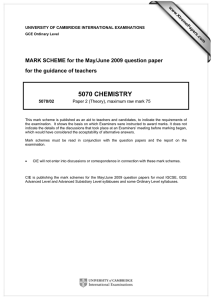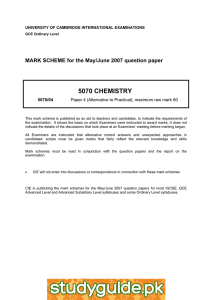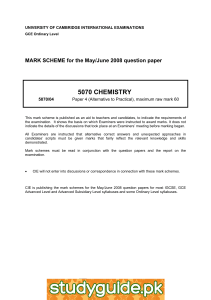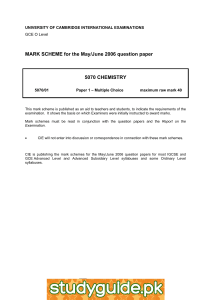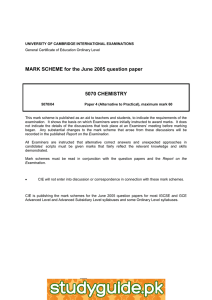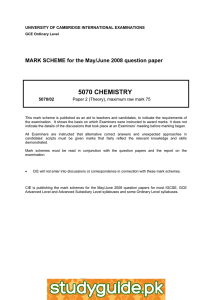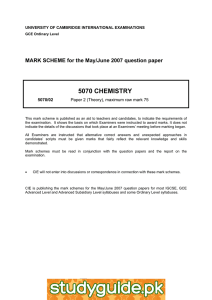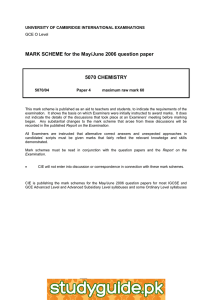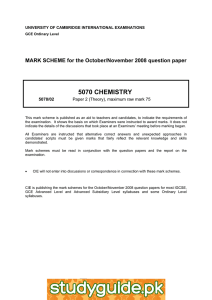5070 CHEMISTRY MARK SCHEME for the May/June 2009 question paper
advertisement
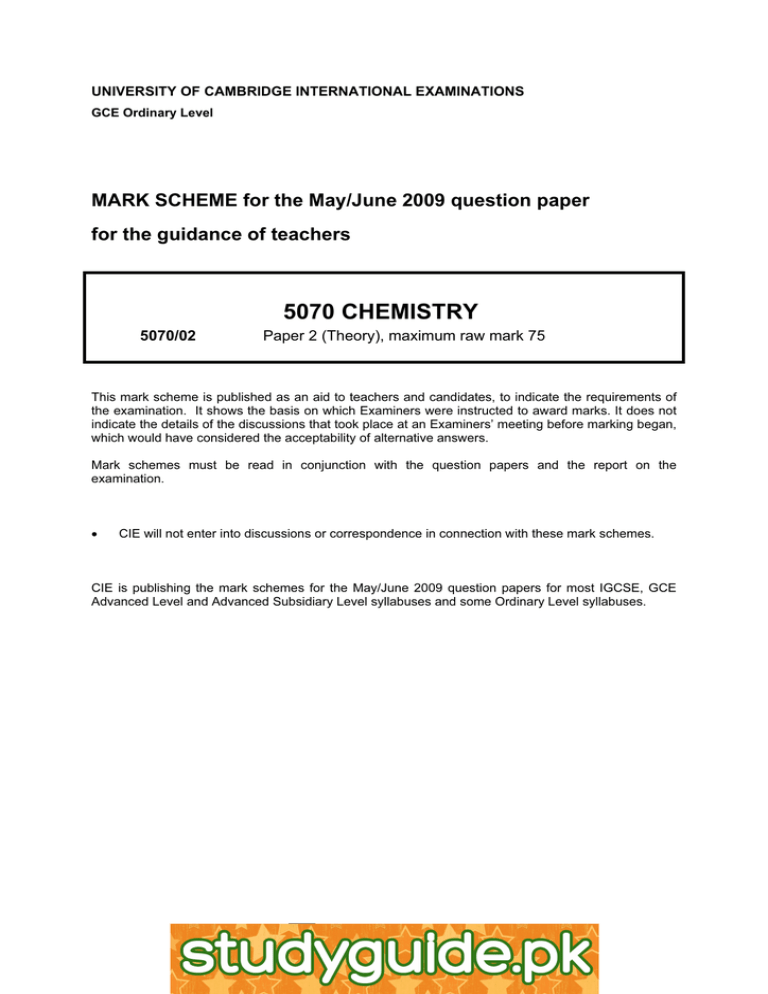
UNIVERSITY OF CAMBRIDGE INTERNATIONAL EXAMINATIONS GCE Ordinary Level MARK SCHEME for the May/June 2009 question paper for the guidance of teachers 5070 CHEMISTRY 5070/02 Paper 2 (Theory), maximum raw mark 75 This mark scheme is published as an aid to teachers and candidates, to indicate the requirements of the examination. It shows the basis on which Examiners were instructed to award marks. It does not indicate the details of the discussions that took place at an Examiners’ meeting before marking began, which would have considered the acceptability of alternative answers. Mark schemes must be read in conjunction with the question papers and the report on the examination. • CIE will not enter into discussions or correspondence in connection with these mark schemes. CIE is publishing the mark schemes for the May/June 2009 question papers for most IGCSE, GCE Advanced Level and Advanced Subsidiary Level syllabuses and some Ordinary Level syllabuses. www.xtremepapers.net Page 2 Mark Scheme: Teachers’ version GCE O LEVEL – May/June 2009 Syllabus 5070 Paper 02 Section A A1 (a) Vandium(V) oxide / V2O5 / vanadium oxide ; NOT: MnO2 ALLOW: vanadium [1] (b) copper(II) chloride / CuCl2 / copper chloride / copper ; [1] (c) ethanoic acid / ethanoic / correct formula ; [1] (d) potassium dichromate(VI) / (potassium) dichromate / correct formula ; NOT: potassium [1] (e) chlorine / (potassium) dichromate(VI) / manganese(IV) oxide ; ALLOW: (concentrated) sulfuric acid [1] [Total: 5] A2 (a) weak forces between layers / van der Waals forces between layers ; ALLOW: weak bonds between layers NOT: the forces are weak / has weak forces between atoms NOT: no forces / bonds between layers NOT: has layers and weak forces NOT: weak forces between molecules NOT: weak electrostatic forces between layers [1] layers can slide / slip ; NOT: atoms slide over each other [1] (b) no mobile / no moving electrons / no delocalised electrons / (all) electrons in covalent bonds ; ALLOW: no free electrons / no sea of electrons IGNORE: no ions [1] (c) Any two of: • hard IGNORE: strong / tough • high melting point IGNORE: high boiling point • lots of strong (covalent) bonds ALLOW: giant structure of strong bonds ALLOW: has strong bonds throughout ALLOW: all the bonds are difficult to break / takes a lot of energy to break all the bonds ALLOW: ideas of all the atoms held together strongly NOT: has covalent bonds / has strong bonds (without qualification) NOT: rigid arrangement of tetrahedral structure NOT: strong forces of attraction between atoms / strong electrostatic forces [2] [Total: 5] © UCLES 2009 www.xtremepapers.net Page 3 Mark Scheme: Teachers’ version GCE O LEVEL – May/June 2009 Syllabus 5070 A3 (a) (i) anode: oxygen / O2 ; NOT: O cathode: copper / Cu ; ions: H+, OH–, SO42– ; (all three needed for the mark) Paper 02 [1] [1] [1] (ii) hydrogen lower in reactivity series (than sodium) / hydrogen lower in discharge series (than sodium) / easier to reduce hydrogen ions (than sodium) / hydrogen ions gain electrons more easily ; ALLOW: it is lower in reactivity series NOT: hydrogen is easier to discharge (than sodium) [1] (iii) chloride ions lower in discharge series than hydroxide ions/ idea of selective discharge of chloride ions/ chloride ion concentration greater than hydroxide ion concentration ; NOT: reference to chlorine / chlorine ions NOT: lower in discharge series than oxygen NOT: chloride ions lower in reactivity than hydroxide [1] (b) (i) purification of copper/ making high grade copper/ IGNORE: uses of copper / for coating metals / for electroplating [1] (ii) temperature: no effect / no change current: increasing current increases mass (of copper) ORA ALLOW: mass proportional to current ALLOW: increase of 1 amp doubles the mass time: increasing time increases mass (of copper) ORA ALLOW: mass proportional to time ALLOW: with the passage of time mass increases [1] [1] [1] [Total: 9] A4 (a) Charges: (b) neutron = 0 / zero / none AND proton = + / plus 1 / +1 ; [1] Relative mass: electron = 0 / negligible / 1/1840 / 1/2000 / 0.0005 AND neutron = 1 / one [1] 11 5 [2] B 1 mark for correct nucleon and proton number as shown ; 1 mark for correct symbol ; (c) 5 electrons in two shells AND 5 protons shown ; number of neutrons other than 6 ; ALLOW: between 3 and 10 neutrons [1] [1] [Total: 6] © UCLES 2009 www.xtremepapers.net Page 4 Mark Scheme: Teachers’ version GCE O LEVEL – May/June 2009 Syllabus 5070 A5 (a) each of 4 chlorine atoms bonded to carbon by pair of electrons ; rest of structure correct i.e. 6 unbonded electrons on each chlorine ; (b) Ca2+ as 2,8,8 and Cl – as 2,8,8 in diagram or as numbers ; correct charges at top right of each structure ; ALLOW: correct ions shown as Ca2+ and Cl – Paper 02 [1] [1] [1] [1] [Total: 4] A6 (a) KNO3 / Ca(NO3)2 / Fe(NO3)2 ; [1] (b) acidic because H+ / hydrogen ions present ; (both acidic and hydrogen ions needed) NOT: hydrogen and nitrate ions [1] (c) moles = 25 × 0.450 = 11.25 / 11.3 / 11 ; mass = 56 × 11.25 = 630 (g) ; [1] [1] (d) (grey-) green precipitate ; of iron(II) hydroxide ; NOT: iron(III) hydroxide / ppt of iron / ppt due to iron(II) ions white precipitate / ppt of calcium hydroxide formed ; ALLOW: idea of calcium hydroxide precipitate masked / cannot be seen NOT: white ppt dissolves in excess [1] [1] [1] (e) add (excess) sodium hydroxide (solution) ; [1] add aluminium / Dervarda’s alloy ; [1] heat / warm ; [1] gas given off turns (moist) red litmus blue/ [1] ALLOW: ammonia gas given off / NOT: smelly gas given off NOTE: this mark is consequential on both the reagents Al and sodium hydroxide being correct OR mix solution with (freshly made) iron(II) sulfate (solution) ; (1 mark) add concentrated sulfuric acid ; (1 mark) idea of making layer of sulfuric acid over the solution / idea of two layers ; (1 mark) brown ring (at interface) ; (1 mark) NOTE: this mark is consequential on both the reagents being correct but sulfuric acid does not have to be concentrated [Total: 11] © UCLES 2009 www.xtremepapers.net Page 5 Mark Scheme: Teachers’ version GCE O LEVEL – May/June 2009 Syllabus 5070 Paper 02 A7 (a) correct structure of chloroethene ; ALLOW: CH2=CHCl NOT: CH2CHCl [1] (b) (i) 2 – C2H3Cl – + 5O2 → 2HCl + 4CO2 + 2H2O ALLOW: multiples / fractions [1] (ii) calcium chloride ; ALLOW: CaCl2 [1] (c) correct name of condensation polymer ; correct use of the named polymer ; e.g. nylon (1) clothing / fishing lines / fishing nets / ropes / stockings / parachutes / toothbrush (bristles) / balloons / guitar strings / racquet strings / petrol tanks (1) IGNORE: fibres without qualifications polyester / terylene / mylar / PET (1) terylene: clothing / sheets / pillowcases / furniture coverings / curtains / carpets / ropes / sails / machinery belts PET: bottles and any of the above mylar: balloons polyester: any of the above (1) IGNORE: fibres without qualifications Kevlar (1) bullet proof vests / canoes / racquets / car tyres (as composite) (1) IGNORE: fabrics / textiles / fibres without qualifications [1] [1] [Total: 5] © UCLES 2009 www.xtremepapers.net Page 6 Mark Scheme: Teachers’ version GCE O LEVEL – May/June 2009 Syllabus 5070 Paper 02 Section B B8 (a) crude oil / petroleum heated in fractionating column / idea of fractional distillation ; NOT: ideas of simple distillation / reference to distillation in the lab Any one of: • separated according to different boiling point (from other fractions) / fractions have different boiling points / has specific range of boiling points ; NOT: incorrect references to petrol e.g. petrol has the lowest boiling points so comes off at the top • separated according to size of molecules (from other fractions) / fractions have different chain lengths ; • petrol made by cracking of long chained hydrocarbons / gas oil / kerosene ; • equation showing cracking (b) (i) 10 800 g / 10.8 kg [1] [1] [1] (ii) moles carbon dioxide = 10 800 / 44 = 245.45 ; moles octane = 245.45 / 8 = 30.68 ; ALLOW: 1 mark for showing division of moles of carbon dioxide by 8 or 16/2 Mr of octane 114 ; Mass of octane = 114 × 30.68 = 3497.5 (g) / 3498 (g) / 3500 (g) ALLOW: 1 mark for multiplying moles of octane by 114 with correct answer for that calculation. [1] [1] [1] [1] (c) CO converted to carbon dioxide ; NO / nitrogen oxide(s) converted to nitrogen ; ALLOW: CO + NO → CO2 + ½N2 = 2 marks (even if not correctly balanced) [1] [1] (d) acid rain / effect of acid rain/ smog ; IGNORE: breathing difficulties / irritation of nose and throat [1] [Total: 10] © UCLES 2009 www.xtremepapers.net Page 7 Mark Scheme: Teachers’ version GCE O LEVEL – May/June 2009 Syllabus 5070 Paper 02 B9 (a) Any three of: (1 mark each) • have general formula / each member differs by CH2 group / by Mr of 14 • have same functional group • have similar chemical properties • physical properties show a trend / example of physical property showing trend e.g. boiling points increase with longer carbon chain (b) (i) any value between 105 and 130°C (actual = 117°C) (ii) C6H13OH [3] [1] [1] (c) (i) C2H4 + H2O → C2H5OH IGNORE: state symbols [1] (ii) addition ALLOW: hydration / additional NOT: exothermic [1] (d) use of moles e.g. 180 g glucose → 2 × 46 or 92 g ethanol OR 100 moles glucose (18000 / 180) → 200 moles ethanol ; [1] theoretical yield calculated e.g. 18 kg glucose → 9.2 kg ethanol OR 200 × 46 = 9200 g ethanol ; [1] % yield calculated e.g. 100 × 0.92/9.2 = 10% ; [1] [Total: 10] © UCLES 2009 www.xtremepapers.net Page 8 Mark Scheme: Teachers’ version GCE O LEVEL – May/June 2009 Syllabus 5070 Paper 02 B10 (a) Correct Mr values: (NH4)2SO4 = 132 AND KNO3 = 101 ; [1] % N in (NH4)2SO4 (2 × 14 / 132) = 21.2% / 21.21% ; OR mass of N in 500 g = 500 × 28/132 = 106.1 g [1] % N in KNO3 (14 / 101) = 13.9% / 13.86% ; OR Mass N in 500 g KNO3 = 500 × 14/ 101 = 69.3 g [1] overall percentage = 17.6% / 17.5(5)% / ; ALLOW: 18 % [1] (b) Any three from: (one mark each) • rapid growth of algae / water weeds / algal bloom ALLOW: rapid growth of (green) plants NOT: plants grow, unqualified (must be increased/ rapid etc) • blocks (sun)light so plants die • bacterial growth increases • bacteria use up oxygen NOT: algae / plants use up oxygen • aquatic life dies / aquatic animals die / fish die because of lack of oxygen NOT: marine organisms die [3] (c) add potassium carbonate solution / potassium hydroxide (solution) ; titration / description of titration AND repeat titration without indicator ; ALLOW: titration with indicator then remove indicator with charcoal crystallise / description of crystallisation AND dry with filter paper / evaporate off some water AND dry in oven / put in oven to allow evaporation of water / allow water to evaporate completely / boil off all the water [1] [1] [1] [Total: 10] © UCLES 2009 www.xtremepapers.net Page 9 Mark Scheme: Teachers’ version GCE O LEVEL – May/June 2009 Syllabus 5070 Paper 02 B11 (a) (i) Electrons lost/ oxidation number (of iron) increases / oxidation number goes from 0 to +2 ; NOT: incorrect oxidation numbers (ii) Fe2+(aq) + 2OH–(aq) → Fe(OH)2(s) correct balanced equation = 1 mark correct state symbols = 1 mark (mark for state symbols dependent on correct formulae) [1] [2] (b) (i) stops water from getting to the surface (of the iron) / stops oxygen getting to surface (of the iron) / stops oxygen / water getting to the iron / stops air getting to the iron / ALLOW: acts as a protective barrier / layer NOT: ideas about sacrificial protection NOT: tin does not react with water / air / tin less reactive than iron [1] (ii) with tin: oxygen / water can react with the iron (where it is scratched) ; NOT: iron more reactive than tin with zinc any two of: • zinc more reactive than iron NOT: zinc oxide protective layer • zinc is sacrificial metal / idea of sacrificial protection i.e. zinc corrodes more readily than iron / zinc reacts first NOT: zinc rusts more readily than iron • zinc loses electrons more readily than iron NOT: zinc displaces iron [1] [2] (c) has layer of (aluminium) oxide that will not flake off / layer of insoluble / unreactive (aluminium) oxide / layer of impermeable (aluminium) oxide / protective oxide layer / NOT: oxide coating without further qualification NOT: forms a protective layer with oxygen [1] (d) correct use ; e.g. drink cans / car bodies / aircraft bodies / high voltage electricity cables / cooking foil / window frames / ladders / ALLOW: cooking utensils / mirrors (as does not corrode) NOT: for cutlery correct explanation related to specific use stated ; e.g. drinks cans → will not react with water / acids car bodies → will not corrode aircraft bodies → lightweight / low density electricity cables → lightweight / good conductor of electricity [1] [1] [Total: 10] © UCLES 2009 www.xtremepapers.net
